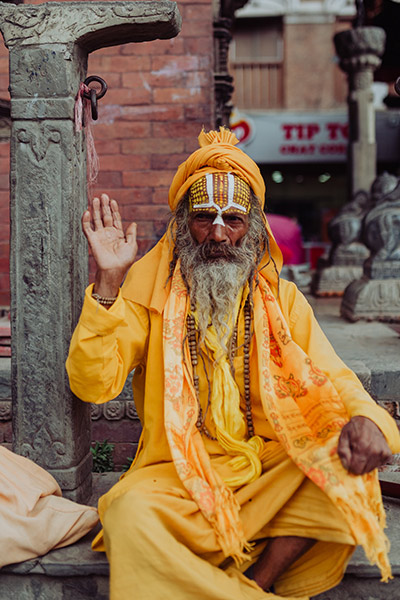Back to series
Two Things on Which Almost All Hindus Agree
Four Roads to Moksha—Two of Them Well Traveled
The Way of Devotion: Bhakti
Christian Analysis



Download or Listen to Audio
A Thumb-Nail Sketch of Hinduism(s) for Christians
Click here to open a Print - Friendly PDF
There is no such thing as Hinduism. (You now know more than the average Christian and will immediately stand out in your next theological debate). The word Hinduism presumes a religion in which the parts are consistent with one another.
But such a religion does not exist. That will no doubt surprise you, but consider this: Hinduism is a word the British coined as a catch-all term for the innumerable and often contradictory religions they found on the Indian subcontinent.
Why do I say contradictory? Because, for example, some Indian religions are theistic (they believe in a personal god) and others aren’t. The latter think the divine is an it, not a Someone. It is an it that includes everything and contains everything (this is called pantheism), but it most certainly is not a Person who created the world or to whom we can pray.
That’s why I say some Indian religions contradict others. Theistic Indian religions contradict pantheistic Indian religions. And these pantheistic religions can actually be called atheistic, because they don’t believe in a personal god who created the world or can save us.
They are religious (they have a reverence for the mystery and spiritual essence of the world) but atheistic (there is no personal god who created or rules the world).
Most Hindus probably would not agree that these different religions are contradictory. They would either say that it doesn’t matter, because religious practice is most important, or that what seems contradictory to us is really harmonious at the “highest” level of reality. (I will explain “levels of reality” below).
Some of these Hindus talk about Hinduism as a journey in which they progress from worshipping a god, to realizing that that god is merely an image of ultimate reality in which there are no
personal gods.
But back to my first point: instead of one religion called Hinduism, there are many religions in India, often contradictory and wildly conflicting in beliefs. That’s why I have titled this essay “A Thumb-Nail Sketch of Hinduism(s).” A more accurate title would be “The Native Religions of India.”
I say “native” because Christianity, Islam, and Buddhism (as well as others) are also flourishing religions in India, with millions of adherents there, but they were founded elsewhere. This essay will focus on Indian religions that got their start on the Indian subcontinent.
There are many different religions that are called Hindu. The Hindu scriptures in fact say there are 330 million gods, and at least several scores of these gods have their own sets of beliefs and practices. So where to start?
I think the best way to make some sense of this huge number of competing and mutually conflicting Indian religions is to (1) look at two concepts about life and death that almost all Hindus believe, and then to (2) see the two major sets of Indian religions (all called Hindu) that try to resolve those two things.
Two Things on Which Almost All Hindus Agree
The first thing most Hindus agree on is samsara. This is pretty much what we call reincarnation. For Hindus it is a combination of karma (literally, “deeds”) and rebirth. It means that after death we are judged by an impersonal law of karma, which determines what kind of life we will be reborn into.
If we performed bad deeds and therefore have bad karma, we will be reborn into an unhappy life as a human being, an animal, or even an insect. If we led a good life and accumulated good karma, then we will be reborn into a happy human life. Samsara is the endless (and without beginning, either) cycle of life, death and rebirth: after each life, we die and are reborn into a different life.
Shirley MacLaine looks forward to her coming rebirths. But in the history of India, most Hindus haven’t. Life has not been very easy for most Hindus, and they sense that the next life is sometimes worse than the present one—especially if they haven’t earned enough good karma in this life. They also hope that eventually they will achieve the second thing most all agree on: moksha.
 Moksha is Sanskrit for “liberation,” which in this case means liberation or release from the iron law of samsara.
Moksha is Sanskrit for “liberation,” which in this case means liberation or release from the iron law of samsara.
In other words, Hindus want to be released from the iron law of life-death-rebirth. They don’t want to be reborn forever and ever. They want to stop the wheel and get off—finally to be free of reincarnation. Most of the assorted varieties of Hindu religions can be seen as ways to get free from samsara and thereby achieve moksha.
Four Roads to Moksha—Two of Them Well Traveled
In Hindu religions there are four main avenues to moksha: the way of knowledge (jnana), the way of devotion (bhakti), the way of works (karma), and the way of meditation (yoga). We are going to look at two of these, because they are the best known and the most widely practiced.
The first, the way of knowledge, is the best known and most prestigious intellectual tradition in “Hinduism.” The second, the way of devotion (bhakti), is far and away the most popular form of Hindu religion today. If you can get a basic idea of how these two Hindu systems work, you will be able to comprehend the basic ways of thinking of the vast majority of Hindus.
The Way of Knowledge: Advaita Vedanta
Take off your Western eyeglasses and be ready to imagine a way of looking at reality that is very different from your own. With a little patience, you can conceive a world that is seen by more than a billion people worldwide (because some features of this philosophy are shared by Daoists and Buddhists).
This way to moksha is called the way of knowledge because it promises that you can escape samsara if you come to see (know) reality in the right way. It takes a lot of work to come to this knowledge or spiritual vision, but the result will be the end to rebirths (and reincarnation).
The most famous teacher of this way was Shankara (AD 788–820), a Brahmin priest and philosopher from south India. Shankara’s system, which has become the most respected school of philosophy for Hindus, is called advaita vedanta.
Understanding what each of these two words means will help us understand his all-important philosophy. Advaita is Sanskrit for “nondual.” This means there are not two (or three or more) things in reality; there is ultimately only one thing. That one thing is Brahman, which is the impersonal, unchanging spirit or essence of the cosmos.
Everything that appears to our eyes and other senses is ultimately unreal. Only eyes that have been opened spiritually can see the underlying reality in all things.
Vedanta means “end of the Vedas.” The Vedas are the early set of Hindu scriptures, the last set of which (the “end” of them) are the Upanishads. These writings, composed between 600 and 400 BC, teach that the human self (atman) is the same as the essence of the cosmos (Brahman).
Shankara taught that we typically think that what is real is distinct from other things and is always changing. So, for example, I think that I am separate from the computer at which I am now looking, and that both the computer and I are constantly changing.
But if I were to attain spiritual knowledge, I would “see” that both the computer and I share an unchanging inner reality, and that this inner essence is more real than the outer forms people see when they look at me and my computer as two different things.
Notice I said “more real.” We in the West usually think in terms of reality and unreality. I am real and a character in a movie—say, Spiderman—is unreal. But in India people have thought in terms of levels of reality. They would point to a nightmare in which a bogeyman is chasing someone; this is a dream I confess I have from time to time.
When I am dreaming this, my heart beats faster, and I may even sweat because I am afraid. Is the bogeyman real? To my dreaming mind, he is very real! That’s why I sweat, and my heart beats faster. But to my conscious mind just after I awake and realize in relief that it was only a dream, the bogeyman is unreal. Hindus would say that, at least while I was dreaming, that bogeyman was real—but at a lower level of reality.
 We Christians might say that Jesus Christ is more real than I am. He was and is the fully real human being, fully actualized. Christians connected to Him are also real, but because of our sins and incomplete sanctification, our humanity is far less real than His. In other words, when we look at Jesus, we see full humanity.
We Christians might say that Jesus Christ is more real than I am. He was and is the fully real human being, fully actualized. Christians connected to Him are also real, but because of our sins and incomplete sanctification, our humanity is far less real than His. In other words, when we look at Jesus, we see full humanity.
When someone looks at me, she does not see a full man, because I am not what God fully intended a human being to be. I am not as really human as Jesus was and is. Humans are meant to love always and love deeply, and my love is sporadic and often superficial. So in this sense we too might say that I am less real, or on a lower level of reality, than Jesus.
This Christian way of talking about levels of reality is different from the Hindu one. But it might help you imagine how Hindus can talk this way. For example, Shankara taught that the gods, human beings, and the world are all real, but only at a level of reality lower than what is at the highest level—Brahman. Each member of these three groups (gods, human beings, and physical world[s]) exists, but only as that bogeyman in my dream exists, or as a murder in a stage play exists.
In the drama on the stage, there really are people fighting one another, and there is a murder weapon and (at least fake) blood, and there are cries of pain. And the people in the audience really do feel excitement and shock and sadness—but only at the level of the play.
They know that at a “higher” level (as Hindus would say) or in “real life” (as Westerners would say), there was no murder. So too for the gods. They have a “certain” reality in our lives here and now. But when all is said and done and we see reality as it really is, we will realize that they are not part of what is fully Real.
Neither is this world. It is like when we are walking in the forest at dusk and look ahead on the trail and see what looks very much like a snake. We get scared (if you’re like me, I hate snakes!) and stop walking forward, wondering how in the world we can get to our destination by another route.
When we realize there is no other way, and we inch forward to get a better look, we suddenly are relieved to discover it was only a rope. We conclude that the snake was only an illusion (maya, in Sanskrit). Shankara said the separate human individual and even the world itself are also maya. The only thing that is “really” real is Brahman, where there are no distinctions between any one thing and anything else.
 Hard to understand? Some Hindus have used the illustration of a drop of water falling out of the sky over the ocean. While that drop is falling, it is an individual drop, with unique characteristics, like no other drop in the world.
Hard to understand? Some Hindus have used the illustration of a drop of water falling out of the sky over the ocean. While that drop is falling, it is an individual drop, with unique characteristics, like no other drop in the world.
It has a unique weight, density, shape, taste, color, and even smell—though the way in which each of these is different from those of other drops is infinitesimally small. Nevertheless, it is a drop like no other in the world. So it is a distinct, individual drop.
Yet when that drop hits the surface of the ocean, in less than a second it loses its individuality. No longer does it have a shape or weight or density. Now the atoms of that drop are dispersed throughout the ocean. Does the drop still exist? Yes and no. No, as a drop with individuality.
But yes, insofar as the particles and molecules of that drop are still around, but they have become merged with the ocean itself. There is now no distinction between the drop and the ocean.
Hindus who adhere to this advaita tradition compare us in our individual selves to that drop, and our future in Brahman to the ocean a moment after that drop has hit the surface. In Brahman, there is no “I.” But in some way that you and I (and even Shankara!) cannot understand, “we” still have some degree of existence. Yet not as individual selves.
Let’s sum up by considering how Shankara thinks we can solve the basic human problem. Every religion says this world is not the way it is supposed to be, that the cosmos has been screwed up in some way. This is what I mean by “the basic human problem.”
Every religion also prescribes what it thinks is the resolution to the basic human problem. I will explain for Shankara, and for bhakti in the next few pages, answers to both of these questions: What is the basic human problem? And how can it be resolved?
Shankara said that the basic human problem is ignorance. (By the way, most religions of the Far East say the same, though each differently defines the object of the ignorance—what we are ignorant of. So while most Hindu and Buddhist religions say the human problem is intellectual, Christianity, Islam and Judaism—the religions that began in the Middle East—say the basic human problem is moral.
Of course to a certain extent, the moral and the intellectual are connected—ignorance leads to immorality, and enlightenment can lead to morality. But still there is this difference: in the Far East more emphasis is placed on our intellectual ignorance; the religions of the Middle East stress more our moral failure).
What are we ignorant of? Brahman, or ultimate reality, which of course contains no distinctions and therefore is finally only one thing.
How do we solve the problem? By meditation and asceticism (keep reading). That means we must meditate on the nature of reality until we finally “see” that everything is Brahman, even the individual self (atman).
But we will attain that final vision only if we combine asceticism with the meditation. This is when we deprive ourselves of the pleasures of the flesh, such as tasty food and drink, a soft bed, sex and marriage, and other sensual enjoyments. Hindus seeking Brahman will often go into the forest to meditate, where they will sleep on the ground and eat the barest of foods, often fasting.
The Way of Devotion: Bhakti
Now that we have explored the most prestigious Hindu path to moksha, let’s turn to the most popular path. It is called bhakti, which is Sanskrit for devotion. This path is a way to liberation from samsara (remember, this is the endless cycle of reincarnation) by means of love and surrender (devotion) to a personal god.
Notice I use the adjective personal. This is because the previous path, advaita, says that the gods are not real at the highest level of reality. So there is no personal god at all. Brahman is not a person (having mind, will, and emotions) and not a god as we tend to think—a Someone who created the world and controls it and will finally put an end to it.
No, Brahman is impersonal, something of an It that is behind and in the world, and in fact is the only thing that is unchanging and fully real.
But bhaktas (devotees of bhakti) believe there are really gods, and they are there at every level, if there are levels at all. Some of them are very powerful and can actually save us from samsara.
They do this by forgiving our sins and getting rid of our bad karma, so that we can live with them forever in one of their heavens. And rather than going through many lives trying to build up good karma and getting rid of bad karma, they will do this for us after this life if we turn to them in sincere faith!
It is no wonder that bhakti is far more popular than advaita or any other way. It is easier (by far!) and much faster. Take Krishna, for example, who is the most popular of all the Hindu gods and the main character and speaker in the most beloved Hindu scripture, the Bhagavad-Gita. Krishna is said to be an incarnation (avatar) of Vishnu, who came to earth to right wrongs and restore righteousness. If one of Krishna’s devotees serves him with love and praise, the devotee will be released from samsara and not be reborn, but enter one of Krishna’s lovely heavens.
As you can see from the previous paragraph, Hindu bhakti contains the idea of incarnation (a god coming “in the flesh”). Its chief god (different from its most popular god, who is Krishna) is Vishnu, the god of order and righteousness, who comes down from the heavens whenever evil is especially bad on earth, so that he can set things aright.
Bhaktas believe Vishnu has come to earth in various incarnations nine times and will come again at the end of time in a tenth incarnation (avatara). His previous incarnations have been as a fish, tortoise, boar, man-lion, dwarf, high-caste hero, Rama (another god), Krishna, and Buddha.
We’ve already seen that although advaita does not believe in the final reality of personal gods and therefore is essentially atheistic, bhaktas are theists. Another difference is that bhaktas believe the human self is real and will retain its individuality even after release from samsara. For bhaktas, there’s no dissolution of the drop of water into the ocean! But bhaktas add that the human self is divine, in fact, a “finite mode” of God.
Still other points of difference: bhaktas say the world is real and change is real, without different levels of reality. But this world is not a place of hope or fulfillment. As we have seen, most Hindus have been pessimistic about their ability to have deep or lasting happiness here on earth. That is changing some, as India joins the global economy and more and more Hindus are becoming prosperous. But philosophically Hindus are taught that true and deep happiness cannot be found in this world system.
For bhakti, the basic human problem is being stuck in samsara. What keeps us stuck is the combination of our karma and our ignorance of a personal god. The resolution to the problem is to get rid of karma by practicing love and surrender to a personal god (bhakti) and getting grace (prasada) from that god.
 Many Christians have thought that their faith is the only one that has taught salvation by grace. You can see now that this is not the case (though Hindu bhakti might have developed after coming into contact with Christianity).
Many Christians have thought that their faith is the only one that has taught salvation by grace. You can see now that this is not the case (though Hindu bhakti might have developed after coming into contact with Christianity).
Interestingly, there are two kinds of bhakti; one teaches grace more radically than the other.
The first is the monkey school (think of the baby monkey clinging to its mother) that says the god will give us grace only if we cooperate by purifying ourselves. You could say that the monkey school teaches salvation by grace and works.
The cat school (think of the kitten doing nothing while being carried by its mother’s teeth) says that salvation by, let’s say, Krishna (there are other bhakti gods, such as Rama) is entirely by Krishna’s grace. Whatever we do to serve and love Krishna is also only by Krishna’s grace.
Most bhaktas believe human effort and merit are necessary. Krishna and the other gods wait to see who makes good efforts before they confer salvation.
Christian Analysis
What can we say as Christians about these Hindu religions? The first thing we can say is that there are obvious similarities. Avataras are similar to the Christian incarnation of Jesus Christ. Both Hindus and Christians say that God has come to earth to help and save.
There is also the idea of grace—which technically means God doing for human beings what they cannot do for themselves. But there are profound differences. The avataras, as even Hindu scholars concede, are based less on historical reality than theological story.
The stories about Krishna (stealing butter and having amorous affairs with cowgirls), for example, seem to have been a conflation of accounts of several krishnas (heroes) in real history, with supernatural elements added later. Second, there are ten incarnations in history, unlike the one incarnation of Jesus, which did all that was needed to save human beings for all time. Third, these Hindu saviors are less than morally perfect, while Jesus was sinless.
Christian grace is also different from bhakti grace. In the latter, grace is in the context of an impersonal law of the universe (karma) that even the gods cannot change. In Christian faith, on the other hand, Jesus Christ is the author of the law, and He has canceled the power of that law over us.
But more important, a self-indulgent Krishna forgives sins at no cost to Himself. Jesus Christ, on the other hand, was sinless and gives us grace only by an infinitely painful atonement. Grace cost Him everything.
There are other differences as well, between both Hindu schools and Christian faith:
1. Ultimate concern: freedom from guilt, sin, and the devil (Christian) versus escape from the human condition (Hindu)
2. Human nature: creaturely and sinful (Christian) versus divine (Hindu)
3. Human problem: moral sin (Christian) versus intellectual ignorance (Hindu)
4. Resolution: divine act at infinite cost to God (Christian) versus human effort sometimes mixed with grace, without cost to the god (Hindu)

Gerald McDermott
Professor Gerald McDermott, Professor, is a retired Anglican Chair of Divinity at Samford’s Beeson Divinity School. Prior to that, he served as Jordan–Trexler Professor of Religion at Roanoke College where he taught for 26 years. His career focuses on Jonathan Edwards, a Christian’s understanding other religions, and the meaning of Israel. Gerald has authored many books, including his award-winning coauthoring of Theology of Jonathan Edwards. He grew up in Boston, New York, and Philadelphia. He graduated from the University of Chicago (B.A., New Testament and Early Christian Literature). Gerald started and ran a private school, pastored for five years in Iowa, and earned a Ph.D. in religion at the University of Iowa.
 COPYRIGHT: This publication is published by C.S. Lewis Institute; 8001 Braddock Road, Suite 301; Springfield, VA 22151. Portions of the publication may be reproduced for noncommercial, local church or ministry use without prior permission. Electronic copies of the PDF files may be duplicated and transmitted via e-mail for personal and church use. Articles may not be modified without prior written permission of the Institute. For questions, contact the Institute: 703.914.5602 or email us.
COPYRIGHT: This publication is published by C.S. Lewis Institute; 8001 Braddock Road, Suite 301; Springfield, VA 22151. Portions of the publication may be reproduced for noncommercial, local church or ministry use without prior permission. Electronic copies of the PDF files may be duplicated and transmitted via e-mail for personal and church use. Articles may not be modified without prior written permission of the Institute. For questions, contact the Institute: 703.914.5602 or email us.
-
Recent Podcasts
An Unexpected Change – David Westerhoff’s Story
by David Westerhoff on November 8, 2024David Westerhoff’s faith never really extended outside of...Read More
-
The Faith of Jonathan Edwards
by Aimee Riegert, Arthur W. Lindsley on November 1, 2024
-
A Scientist’s Journey to God – Krister Renard’s story
by Krister Renard, Jana Harmon on October 25, 2024
-
Recent Publications
Will You Be Ready?
by Thomas A. Tarrants on October 23, 2024Tom Tarrants gives insights on how we can...Read More
-
Should Christians Be Involved with Politics?
by Kerry A. Knott on October 1, 2024
-
Isn ’t Atheism Based on Scientific Fact Whereas Christianity is Based on “Faith”?
by Cameron McAllister on September 1, 2024
0
All Booked
0.00
All Booked
0.00
All Booked
23169
ADVENT CALENDAR: The Amazing Prophecies Fulfilled by the Birth of Jesus Christ
https://www.cslewisinstitute.org/?event=advent-calendar-the-amazing-prophecies-fulfilled-by-the-birth-of-jesus-christ&event_date=2024-11-28®=1
https://www.paypal.com/cgi-bin/webscr
2024-11-28

Next coming event
Days
Hours
Minutes
Seconds
ADVENT CALENDAR: The Amazing Prophecies Fulfilled by the Birth of Jesus Christ
On November 28, 2024 at 6:00 amSpeakers

Gerald McDermott
Professor
Team Members

Gerald McDermott
ProfessorGerald McDermott, Professor, is a retired Anglican Chair of Divinity at Samford’s Beeson Divinity School. Prior to that, he served as Jordan–Trexler Professor of Religion at Roanoke College where he taught for 26 years. His career focuses on Jonathan Edwards, a Christian’s understanding other religions, and the meaning of Israel. Gerald has authored many books, including his award-winning coauthoring of Theology of Jonathan Edwards. He grew up in Boston, New York, and Philadelphia. He graduated from the University of Chicago (B.A., New Testament and Early Christian Literature). Gerald started and ran a private school, pastored for five years in Iowa, and earned a Ph.D. in religion at the University of Iowa.




